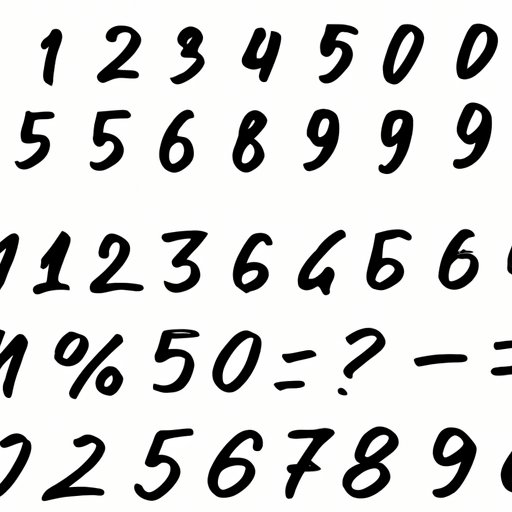
I. Introduction
Writing checks is a common and important part of managing finances for many people and businesses. One important aspect of writing checks is properly writing the amount in words. While it may seem straightforward, there are important rules and conventions to follow when writing numbers as words on a check. In this article, we will provide a step-by-step guide for writing numbers in words on a check, tips and tricks for accuracy, and explain the importance of doing it correctly.
II. Step-by-Step Guide for Writing Numbers in Words on Checks
Writing numbers in words on a check can be broken down into several simple steps:
A. How to Write Whole Numbers
When writing a whole number on a check, start by writing out the word for the number in full. For example, if the amount is $500, write “five hundred” in the space provided for the amount in words. Be sure to write the word legibly and neatly.
B. How to Write Decimal Numbers
When writing a decimal number on a check, use the word “and” to separate the whole number from the decimal. For example, for an amount of $44.50, write “forty-four and 50/100” in the space provided for the amount in words.
C. How to Write Cents in Words
When writing cents in words on a check, use the fraction “100” followed by the word “cents.” For example, for an amount of $25.75, write “twenty-five and 75/100 cents” in the space provided for the amount in words.
D. Examples to Clarify the Process
Here are a few examples to help illustrate the process of writing numbers in words on a check:
- $100.00 = one hundred dollars and 00/100 cents
- $852.33 = eight hundred fifty-two dollars and 33/100 cents
- $1,250.50 = one thousand two hundred fifty dollars and 50/100 cents
III. Tips and Tricks for Writing Numbers in Words on a Check
In addition to following the step-by-step guide above, there are several tips and tricks you can use to ensure accuracy when writing numbers in words on a check:
A. Use Hyphens Correctly
When writing compound numbers (numbers greater than 100 or with a decimal), use hyphens to separate the words in the number. For example, for an amount of $2,345.67 write “two thousand three hundred forty-five and 67/100.”
B. Double-check for Accuracy
After writing the amount in words on a check, double-check the spelling and accuracy of the amount. Ensure that the amount written in numbers and the amount written in words match exactly.
C. Use a Consistent Style
When writing numbers in words on a check, be consistent with the style used. For example, if you write out the word “dollars” for one amount, don’t use the symbol “$” for another amount. Use the same style for each amount to avoid confusion or mistakes.
IV. Understanding the Importance of Writing Numbers in Words and How to Do It Correctly on Checks
Writing numbers in words on a check is important for several reasons:
A. Legal Implications of Incorrect Number Writing
If the amount written in words on a check does not match the number written in numbers, it can have legal and financial implications. Banks may not accept the check, and it can lead to disputes or confusion over the actual amount intended to be paid.
B. Avoiding Fraud and Mistakes
When numbers are written as words, it is more difficult for fraudsters to alter the amount on a check. Additionally, writing the amount in words can help avoid mistakes or confusion when making a payment.
C. Clear Communication through Writing
Writing numbers in words on a check ensures clear communication between the payer and the payee. It eliminates any confusion over the amount that is to be paid or received.
V. The Dos and Don’ts of Writing Numbers as Words on Checks
There are a few important dos and don’ts to keep in mind when writing numbers in words on a check:
A. Dos:
- Be consistent with the style used
- Use proper grammar and hyphenation
- Write numbers legibly
B. Don’ts:
- Do not use abbreviations
- Do not use different numbering styles repeatedly
- Do not mix numerical figures with written words
VI. A Beginner’s Guide to Writing Numbers in Words on a Check
For those new to writing checks, here are a few examples of commonly-encountered check amounts:
- $10.00 = ten dollars and 00/100 cents
- $25.50 = twenty-five dollars and 50/100 cents
- $543.21 = five hundred forty-three dollars and 21/100 cents
When writing numbers in words, there are a few rules and conventions to keep in mind:
- For whole numbers, write out the word for the number in full
- Use the word “and” to separate the whole number from the decimal
- Use hyphens to separate words in compound numbers
- Write cents using the fraction “100” followed by “cents”
For additional practice and resources on writing numbers in words on a check, consult the website of your bank or financial institution.
VII. Conclusion
Writing numbers in words correctly on a check is an important skill to have when managing finances. Following the step-by-step guide, tips and tricks, and best practices explained in this article can help avoid fraud, mistakes, and legal issues. Remember, consistency is key when writing numbers in words on a check.





